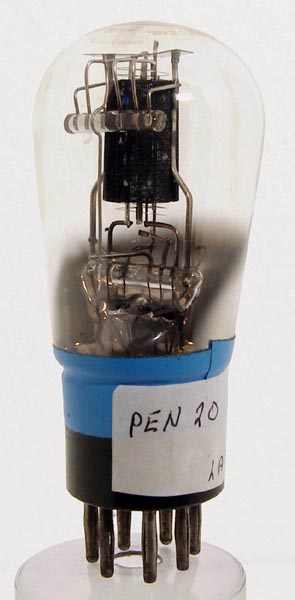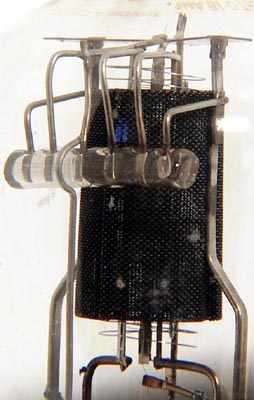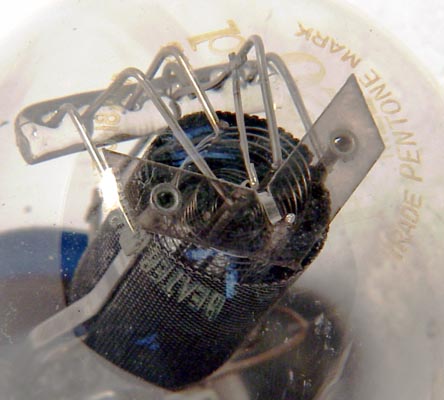
|
The Pen20 was made in both B5 and B7 bases. The B7 base was introduced in that year. By 1935 the type was obsolete, note the non standard heater requirements of 20 Volts at 180 mA. To achieve the modest 1.5 Watts output the anode load was 8,000 Ohms.
Above can be seen the mesh anode, the glass electrode support and passing through the anode is the bright helical suppressor grid.
Seen from the top the oxide cathode, and grids become clear.
In the final close-up the whole of the electrodes can be seen in their concentric form. The supports passing from the glass rod to the individual grids is visible.Having invested heavily in the azide process, which was not suited to the manufacture of indirectly-heated types, Mullard-Philips were not well placed to supply the sudden demand in the early 1930s for indirectly-heated valves for mains radios.On the Continent, Philips coped by making and marketing its own AC mains radios using directly-heated valves where it could not supply indirectly-heated equivalents but Mullard was not itself a radio manufacturer and had to market its valves in competition with suppliers like Mazda who had a head start in indirectly-heated oxide-coated cathodes.The Pen20 was one of Mullard's earlier offerings, intended for DC mains radios only. Its construction details are interesting. It appears to have an uninsulated single-strand heater wire threaded through a ceramic tube insulator round which is wrapped the metal substrate of the coated cathode. This is an inefficient method of heater insulation pre-dating the successful slip-coated insulation introduced by Cosmos (later Mazda) in 1928.Even more interesting is the fact that the design of the electrode structure is based on glass-bead supports placed 'out of the firing line' as required for the azide process, which was incompatible with modern mica electrode supports. However, the degree of support seems to have been insufficient because it has had to be supplemented by a mica support in recognition that this is not an azide type.This series of Mullard valves was not a success. Heat transfer through the thick ceramic tube insulation was so inefficient that the cathode coating did not get to the correct temperature unless the single-strand heater was run almost white hot. The heater therefore emitted electrons, making AC operation unsatisfactory, and valve life tended to be unacceptably short.The valve in the picture is probably new and unused. Most existing specimens are horribly blackened on the inside of the glass due to evaporation from the exposed ends of the over-hot heater strand.The rapid replacement of DC mains by AC systems during the mid 1930s mercifully made this series of valves obsolete and forced Philips-Mullard to develop more successful types.The balloon envelope is 47 mm in diameter and, excluding the B7 base pins, is 100 mm tall.References: Private communication, data-sheet, 1043 & 4024. Type Pen20 was first introduced in 1932. See also 1932 adverts. |
Pin Connections
| 1 | 2 | 3 | 4 | 5 | 6 | 7 |  nc | g1 | g2 | h | h | k,g3 | a |
|
|
Absolute Maximum Operating Conditions¶
| Vh | Ah | Va | Vs | Vg | mAa | mAs | Pout | 
| 20.0 | 0.18 | 200 | 200 | -15.0 | 25.0 | 9.0 | 1.5W |
|
Thanks to Andy Cowley for supplying the above PDF datasheet. |
Updated January 03, 2022.
|
|